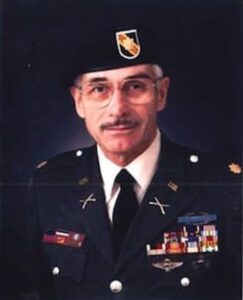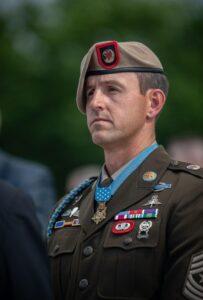 Rank: General, Brigadier General at beginning of World War II
Rank: General, Brigadier General at beginning of World War II
Organization: U.S. Army
Division: Air Corps
Conflict: WWII
Date of Actions: 4/18/1942
Date of Issue: 6/9/1942
Medal Presented By: President Franklin D. Roosevelt
“Just try to make the world a better place for your having been here.” – James Doolittle
General James “Jimmy” Doolittle is one of the greatest aviation figures of the 20th Century. In 1922, he was the first pilot to fly coast to coast in under 24 hours. Later, he helped develop instruments to allow pilots to fly in white-out conditions, without seeing the ground, and was the first airman to fly “blind” using instruments alone.
For leading the daring air raid on Tokyo following the bombing of Pearl Harbor, Doolittle received a Medal of Honor from President Franklin D. Roosevelt. He went on to become one of the top air commanders of World War II, heading the 12th, 15th and 8th Air Forces at various times, and was a leading voice advocating for racial integration in the military.
Immediately following the war, he became vice president and director of Shell Oil Co., where he pushed for the adoption of advanced aviation fuel. In continued demonstration of patriotism, he also served on many government advisory committees. Notably, he advised the Air Force and the Central Intelligence Agency (CIA). At one point, while visiting a top-secret CIA facility, Doolittle identified an image taken over the Soviet Union that had stumped photo interpreters for a long time. Doolittle recognized the strange image as a “wing-in-ground effect” vehicle, an airplane that stays very close to the surface.
An aerospace visionary, Doolittle became chairman of the board of Space Technology Laboratories Inc., after declining President Eisenhower’s first offer of the NASA administrator role reporting directly to the president. He was focused on space technology, space exploration and ballistic missile development in his position at Space Technology Laboratories, which allowed him to offer unique advice in his capacity as one of three civilian advisors on the Space Council, guiding Eisenhower in the development of American space policy.
In a 1982 interview, the professional flier noted, “I believe in excellence, and I believe in reward for excellence…I’ve tried all my life to do things as well as I could do them, sometimes successfully. Sometimes I’ve failed…There have been disappointments, and successes, and successes are what you enjoy most, but the disappointments may be what you learn most from, because you analyze what happened and you are better prepared to cope the next time.”
James Doolittle is one of the 3,500 Medal of Honor recipients whose combat valor and civic heroics will be enshrined in the National Medal of Honor Museum at Patriots Point in Mount Pleasant, SC. These heroes deserve a home for their legacy to be shared with the next generations.
As the only military museum to recognize all branches of the armed services, it will highlight the fact that the recipients of our nation’s highest military award not only defended our country, they were instrumental in developing, designing, and enriching it.
The museum will be a vault for the values embodied in the Medal of Honor: courage, sacrifice and patriotism. It will showcase the Congressional Medal of Honor Foundation Character Development Program including living histories of over 100 recipients. It will also house the Citizens Heroes Program honoring ordinary citizens who have epitomized the concept of “service above self”.
Americans will walk out of that museum with the conviction that they too can be a hero, inspired by the values of courage and sacrifice that the Medal of Honor recipients used to excel in combat and in civilian life. Learn more at mohmuseum.org.

Navigating the Darkest Night | The Courageous Leadership of Rear Admiral Bruce McCandless
Recipient: Bruce McCandless Branch: U.S. Navy Combat: World War II Sometimes fate has a way of showing us exactly where we need to be and


